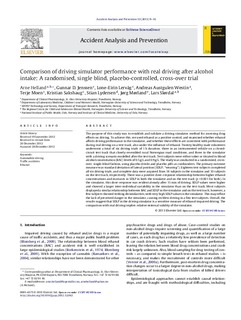| dc.contributor.author | Helland, Arne | |
| dc.contributor.author | Jenssen, Gunnar Deinboll | |
| dc.contributor.author | Lervåg, Lone-Eirin | |
| dc.contributor.author | Westin, Andreas Austgulen | |
| dc.contributor.author | Moen, Terje | |
| dc.contributor.author | Sakshaug, Kristian | |
| dc.contributor.author | Lydersen, Stian | |
| dc.contributor.author | Mørland, Jørg | |
| dc.contributor.author | Slørdal, Lars | |
| dc.date.accessioned | 2016-11-18T15:15:39Z | |
| dc.date.accessioned | 2016-11-23T12:39:21Z | |
| dc.date.available | 2016-11-18T15:15:39Z | |
| dc.date.available | 2016-11-23T12:39:21Z | |
| dc.date.issued | 2013 | |
| dc.identifier.citation | Accident Analysis and Prevention 2013, 53:9-16 | nb_NO |
| dc.identifier.issn | 0001-4575 | |
| dc.identifier.uri | http://hdl.handle.net/11250/2422676 | |
| dc.description.abstract | The purpose of this study was to establish and validate a driving simulator method for assessing drug effects on driving. To achieve this, we used ethanol as a positive control, and examined whether ethanol affects driving performance in the simulator, and whether these effects are consistent with performance during real driving on a test track, also under the influence of ethanol. Twenty healthy male volunteers underwent a total of six driving trials of 1 h duration; three in an instrumented vehicle on a closed-circuit test track that closely resembled rural Norwegian road conditions, and three in the simulator with a driving scenario modelled after the test track. Test subjects were either sober or titrated to blood alcohol concentration (BAC) levels of 0.5 g/L and 0.9 g/L. The study was conducted in a randomised, cross-over, single-blind fashion, using placebo drinks and placebo pills as confounders. The primary outcome measure was standard deviation of lateral position (SDLP; “weaving”). Eighteen test subjects completed all six driving trials, and complete data were acquired from 18 subjects in the simulator and 10 subjects on the test track, respectively. There was a positive dose–response relationship between higher ethanol concentrations and increases in SDLP in both the simulator and on the test track (p < 0.001 for both). In the simulator, this dose–response was evident already after 15 min of driving. SDLP values were higher and showed a larger inter-individual variability in the simulator than on the test track. Most subjects displayed a similar relationship between BAC and SDLP in the simulator and on the test track; however, a few subjects showed striking dissimilarities, with very high SDLP values in the simulator. This may reflect the lack of perceived danger in the simulator, causing reckless driving in a few test subjects. Overall, the results suggest that SDLP in the driving simulator is a sensitive measure of ethanol impaired driving. The comparison with real driving implies relative external validity of the simulator. | nb_NO |
| dc.language.iso | eng | nb_NO |
| dc.publisher | Elsevier | nb_NO |
| dc.rights.uri | https://creativecommons.org/licenses/by-nc-nd/3.0/ | |
| dc.title | Comparison of driving simulator performance with real driving after alcohol intake: A randomised, single blind, placebo-controlled, cross-over trial | nb_NO |
| dc.type | Journal article | nb_NO |
| dc.type | Peer reviewed | nb_NO |
| dc.date.updated | 2016-11-18T15:15:39Z | |
| dc.subject.nsi | VDP::Medisinske fag: 700::Basale medisinske, odontologiske og veterinærmedisinske fag: 710::Rettsmedisin, rettsodontologi: 720 | nb_NO |
| dc.subject.nsi | VDP::Midical sciences: 700::Basic medical, dental and veterinary sciences: 710::Forensic medicine, forensic dentistry: 720 | nb_NO |
| dc.source.pagenumber | 9–16 | nb_NO |
| dc.source.volume | 53 | nb_NO |
| dc.source.journal | Accident Analysis and Prevention | nb_NO |
| dc.identifier.doi | 10.1016/j.aap.2012.12.042 | |
| dc.identifier.cristin | 1034901 | |
| dc.description.localcode | Attribution-NonCommercial-NoDerivs 3.0 Unported (CC BY-NC-ND 3.0) | nb_NO |

